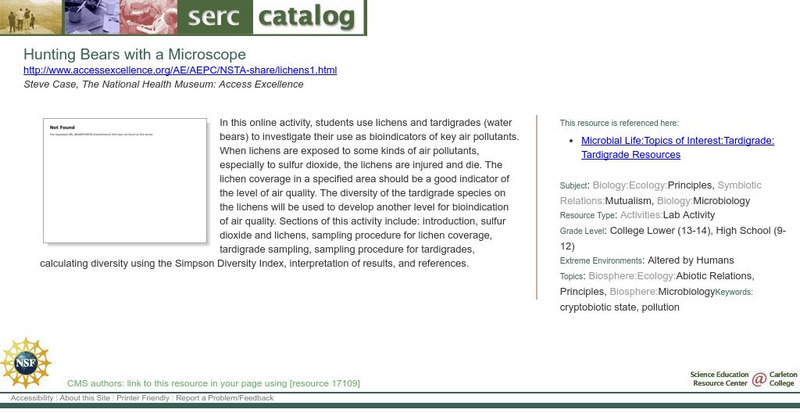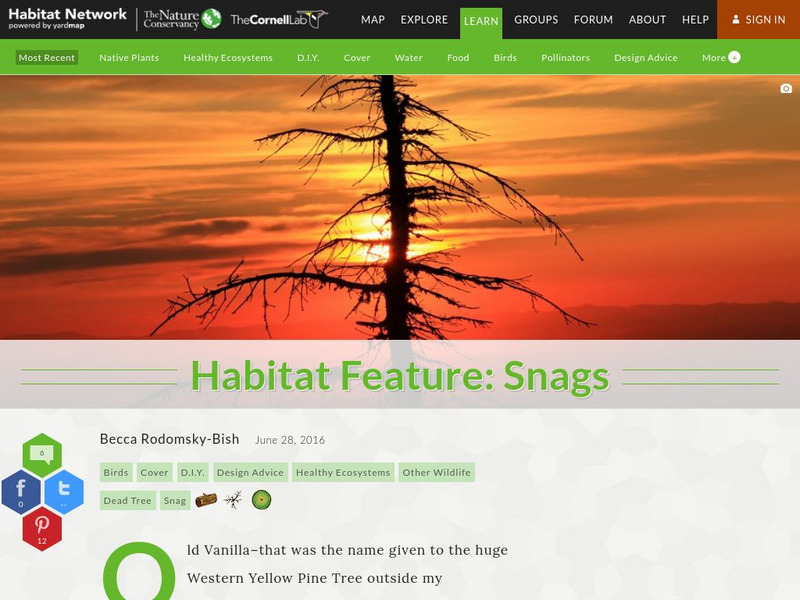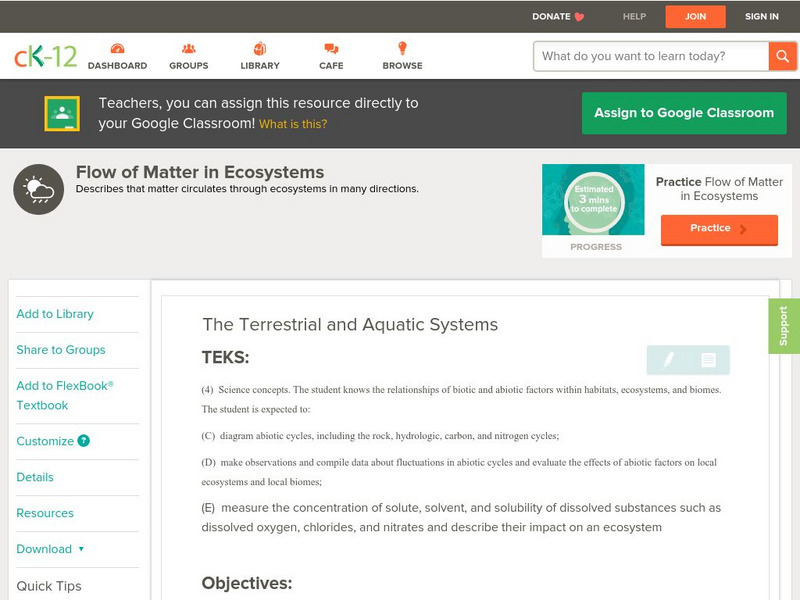SMART Technologies
Smart: Living and Nonliving Things
Students define the characteristics of living and non-living things, identify living and non-living components of an ecosystem, and identify the roles of organisms in living systems.
Science Education Resource Center at Carleton College
Serc: Healthy Waters
By the end of this lesson, young scholars will understand how we can use macroinvertebrates to determine the quality of water in a river or stream.
National Center for Ecological Analysis and Synthesis, University of California Santa Barbara
Kids Do Ecology: Learn About Ecology
This resource provides information about ecology.
E-learning for Kids
E Learning for Kids: Science: Marshall Islands: How Can We Tell Living Things From Non Living Things?
Andrea lives on the Marshall Islands, and she will teach you about living and nonliving things.
Texas Instruments
Texas Instruments: Probing an Aquatic Ecosystem
In this activity, students' use a pH sensor and Temperature Sensor to measure and compare the pH and temperature of three aquariums over a period of several weeks. They will compare and understand how plants and animals affect the water...
Science Education Resource Center at Carleton College
Serc: Hunting Bears With a Microscope
In this study, students will use lichens and tardigrades (water bears) to investigate their use as bioindicators of key air pollutants.
Cornell Lab of Ornithology
Habitat Network: Habitat Feature: Snags
Find out how dead trees can be beneficial to a backyard habitat.
Cornell Lab of Ornithology
Habitat Network: Habitat Feature: Shelter for Reptiles and Amphibians
Find out why creating and conserving habitat for amphibians and reptiles is important.
Cornell Lab of Ornithology
Habitat Network: Living Fences
Find out what living fences are, and how they increase diversity.
Cornell Lab of Ornithology
Habitat Network: Snags: Nature's Apartment Complexes
Find out why the sometimes hazardous or untidy dead trees are actually quite important to wildlife.
CK-12 Foundation
Ck 12: Earth Science: Flow of Matter in Ecosystems
[Free Registration/Login may be required to access all resource tools.] In this module, students will learn about the cycles of nature (water, carbon, nitrogen, and phosphorus) that support the flow of nutrient matter through an...
CK-12 Foundation
Ck 12: Biology: Importance of Biodiversity
[Free Registration/Login may be required to access all resource tools.] Describes the causes of species diversity in an ecosystem, why it is important for an ecosystem to have stable biodiversity, what happens if it becomes unstable, and...
CK-12 Foundation
Ck 12: Life Science: 12.11 Habitat and Niche
See how organisms each have their own role in the ecosystem.
CK-12 Foundation
Ck 12: Life Science: 12.10 Ecosystems
See how living and nonliving things exist together in an ecosystem.
CK-12 Foundation
Ck 12: Earth Science: Biological Communities Study Guide
Review the relationship between populations and ecosystems.
ArtsNow
Arts Now Learning: Dramatic Living and Non Living [Pdf]
Students explore the differences between living and nonliving things through the lens of the nursery rhyme, "Hey Diddle Diddle." After bringing the characters to life, the students discuss the concepts of living and nonliving and act out...
Sophia Learning
Sophia: Ecosystem: Lesson 1
This lesson will introduce the properties of ecosystems. It is 1 of 4 in the series titled "Ecosystem."
Other popular searches
- Biotic Abiotic
- Biotic and Abiotic Factors
- Biotic and Abiotic
- Abiotic Biotic Environment
- Abiotic and Biotic Elements
- Abiotic and Biotic Resources
- Biotic Abiotic Factors
- Abiotic Biotic Lab
- Ecosystems Abiotic Biotic
- Biotic Abiotic Pictures
- Biotic Abiotic Piotures
- Biotic or Abiotic Changes














